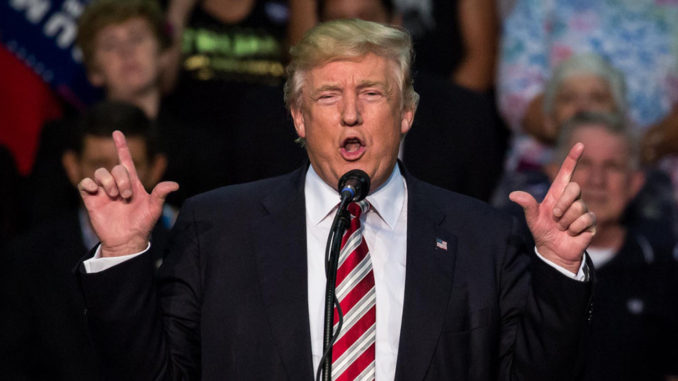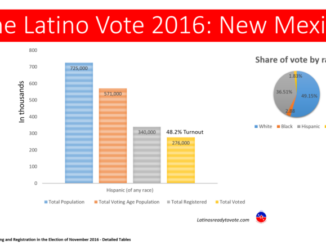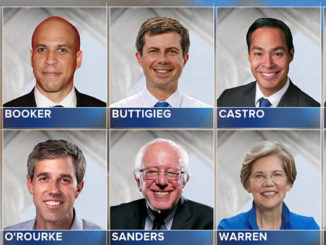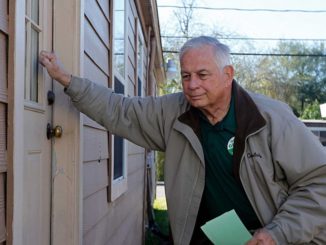
by Marc Caputo, POLITICO
Donald Trump could win the biggest battleground state in spite of himself.
The nation’s biggest battleground state should have buried Donald Trump’s White House hopes.
With Florida’s booming Hispanic population, Trump’s harsh immigration rhetoric sounded like political suicide. In a state where TV ads drive the electorate, Trump penny-pinched on air time. And though organization is a must here, Trump had no field offices for months and he replaced his Florida campaign manager in a shakeup less than a month before officials mail out absentee ballots to voters.
Yet he is essentially tied with Hillary Clinton and even leads her in some polls, a gravity-defying feat that is keeping Florida’s 29 electoral votes in play — and Trump’s chances in the Electoral College alive.
“Trump might win Florida in spite of himself,” said Brian Burgess, a Tallahassee-based consultant and former spokesman for Gov. Rick Scott’s official office and his successful 2010 campaign where, like Trump, he ran as an outsider.
“He may have found some sort of magic formula — celebrity and an ability to tap into the mood of the electorate — to win without a traditional campaign,” Burgess said. “But his one point lead in the polls can easily get erased by a handful of dedicated Democrat field operatives who turn out the vote in South Florida. In a tight race like this, the ground game makes all the difference.”
Consultants and experts like to say “campaigns matter” — a nod to the importance of a good field organization. Trump will test that theory like no other campaign in Florida, where the past three top-of-the-ticket races were decided by a single percentage point.
By traditional standards, Trump hasn’t had a ground game until last week. That function was left in the hands of the Republican National Committee, which has been organizing and registering voters in Florida for two years.
Clinton took no such chances. She began opening voter-outreach field office in spring, and now counts 57 of them. Trump’s campaign didn’t sweat it. He only began opening offices last week; 13 are up and running now, nine more are slated for Tuesday. In July, as they both secured their party’s nominations, she and her allies began what has been, as of Monday, a $21 million general-election ad campaign. Trump and his allies have spent just $7.5 million in a state with 10 major media markets.
But at its core, the race is about race, about motivating white versus non-white voters. The whiter the electorate, the likelier it is Trump wins. And older whites are keeping Trump in the hunt.
Without the backing of older whites, polls indicate Trump would lose Florida — in this retirement mecca, the elderly are still a force at the ballot box. Of Florida’s 12.4 million active registered voters, more than 3.3 million are older than 65 years old, making them the largest age group on the rolls (followed by those 50 to 64). The elderly also have the highest turnout rate in Florida.
When it comes to race, non-Hispanic whites are 65 percent of the overall voter rolls and are the most-reliable voters. So Trump’s base is easier to turn out in big numbers. If he can keep Clinton’s white support below 35 percent (Obama won 37 percent, according to 2012 exit polls) and boost white turnout by just a few points, Florida operatives say he’ll likely win the state.
Polling from local legislative and congressional races throughout Florida shows Trump is running stronger than 2012 GOP nominee Mitt Romney in the suburban areas of the Tampa Bay media market and Southwest Florida, according to results of confidential campaign surveys shared with POLITICO on condition of anonymity. Enthusiasm also appears high in Republican-rich North Florida and the Space Coast.
Clinton’s base – African-Americans, mixed-race voters, Hispanics — are historically harder to turn out, although they do a better job showing up in presidential election years as opposed to midterm elections. But they disproportionately support her.
An Univision poll this week had the Democratic presidential nominee leading Trump by 24 points among likely Hispanic voters, about 3 points more than President Obama beat Romney by four years ago to win Florida.
Because of the influence of Republican-leaning Cuban-Americans, Clinton’s poll numbers among Florida Latinos — slightly lower when compared to other battleground states. Another problem for Clinton: a plurality of Florida Hispanics, 46 percent, agreed with the sentiment that she is a “liar,” although they trusted her more than Trump in the poll that was conducted by Bendixen & Amandi International and the Tarrance Group.
Clinton’s campaign says it’s heavily investing in turnout of Puerto Rican voters. Puerto Ricans are the fastest-growing Latino group in the state — and could eclipse the 1.5 million Cuban-Americans in raw numbers by the next presidential election. Clinton’s focus: the urban counties of Southeast Florida, and the cities of Tampa, Daytona Beach, Jacksonville and Orlando, home to the Puerto Rican diaspora.
If the majority of Florida polls are right and non-white voters turn out at the statewide average, she’s expected to win Florida — an outcome that could rest on Puerto Rican turnout near Disney World.
“I absolutely worry about turnout,” said Scott Arceneaux, the executive director of the Florida Democratic Party who’s advising Clinton’s campaign in the state.
“But we’re going to do all we can to turn Puerto Rican voters out. We’re doing it now,” Arceneaux said. “These are folks who have a strong history of voting on the island. And while in gubernatorial election years we have concerns, in presidential election years we believe we will get these folks to cast ballots early and on Election Day.”
With less than three months to go until Election Day, operatives think Donald Trump has already entirely lost several crucial swing states.
Of the five field offices Clinton’s campaign has opened in the Orlando media market, three target the Puerto Rican community. The Clinton campaign late last week began airing its first Spanish-language TV ads. A Florida radio spot released this week features Clinton’s bilingual running mate, Virginia Sen. Tim Kaine, speaking in Spanish. Clinton’s sister in law, Coral Gables attorney Maria Victoria Arias, has begun appearing as a surrogate on Cuban and Spanish language radio in Miami. And President Obama this week phoned a local pop radio station to plug Clinton.
At the same time, three Latino-outreach groups — National Council of La Raza, Mi Familia Vota and Hispanic Federation — say they’ve so far registered 71,000 new Hispanic voters, most since the March 15 presidential primary. They have a combined goal of registering 30,000 more.
But Republicans haven’t been dormant. For two years, the Republican National Committee has methodically trained volunteers and organized a broad outreach effort that included a major voter-registration effort in Florida. Taking a page from Obama for America, the RNC organized the state into 256 “turfs” of roughly 10,000 persuadable voters pursued by small neighborhood-based teams that total about 1,700 statewide, in addition to its paid staff.
After a steady drumbeat of reports concerning Trump’s lack of field offices, the RNC blasted out a Monday email complaining that “the media has fallen for the Clinton camp’s false narrative that equates having a lot of campaign offices with having a superior field organization.” With the subject line “Sleight Of Hand: Clinton Ground Game Lags Trump And RNC,” the RNC boasted that more Republicans have been added to the voter rolls than Democrats in key states, including Florida.
But Democrats have actually beaten Republicans in Florida in registering new voters this year. Of the 651,000 new Florida voters added from Jan. 1 to Sept. 1, 34 percent are Democrats, 35 percent are No Party Affiliation independents and 28.4 percent are Republican, according to University of Florida political science professor Daniel A. Smith’s analysis of the voter rolls.
What looks like a net GOP gain in voter registrations is heavily composed of conservative Democrats and independents finally deciding to register the way they typically vote anyway: Republican.
“However you factually slice it, Democrats are winning the registration game,” Smith said, taking issue with the “sleight of hand” email from the RNC. “Who’s doing the magic tricks? The RNC is pretending to pull some Republican rabbits out of a magic hat.”
Democrats still outnumber registered Republicans by 38 percent to 36 percent. Independents are growing fastest, fueled by Hispanics, who account for more than 15 percent of the overall voter rolls.
Trump’s new Florida campaign manager, Susie Wiles, didn’t want to discuss the campaign’s decisions in the past, but said she’s trying to blend Trump’s maverick style with the RNC’s data-driven ground game.
“What we are doing is simultaneously leveraging the ways that Donald Trump is not a traditional candidate and at same time, with our partners at the RNC, taking advantage of running a typical campaign,” Wiles said.
Trump’s campaign uses its high-energy events as a draw to register voters and generate nationwide coverage. Last Friday, he held a rally in Pensacola. He holds another in Miami this Friday, and another near Fort Myers on Monday, when he also might go to Orlando. Vice presidential nominee Mike Pence has a rally in The Villages on Saturday
Clinton’s events are smaller, and her campaign concentrates on issue-oriented events to gin up local headlines. In Miami, she visited a clinic and talked about combating the Zika virus. Trump had to be asked about it during a Florida visit by the press and offered only platitudes praising Gov. Scott. Clinton surrogates have snagged local headlines by talking about the environmental devastation of toxic algae in the St. Lucie River, the effects of climate change at the University of Miami, college affordability in Jacksonville and education policy in Fort Myers.
For Trump, the biggest potential problem of all rests in the one county he lost to Sen. Marco Rubio in his blowout Florida primary win March 15: Miami-Dade County. It’s the most-populous in the state and has the largest concentration of Republicans, 72 percent of whom are Hispanic and mainly Cuban-American.
Even with the backing of Cuban-American leaders, Romney lost Miami-Dade to Obama by 208,000 votes in 2012. That gave the Democrat enough of a cushion to win Florida overall by just 74,000. Unlike Romney, Trump has little institutional support in the county. Among those not backing Trump: the GOP mayor of Miami; Miami-Dade’s Republican mayor and his challenger; Lt. Gov. Carlos Lopez-Cantera; former Gov. Jeb Bush and two of the area’s three Cuban-American Republican U.S. House members.
If that lack of elite Miami GOP support is indicative of broader rank-and-file sentiment in the county, one Republican organizer in Florida said, Trump could see a “nightmare scenario … Clinton gets a 300,000 vote margin in Miami-Dade. If that happens, we should just start drinking early.”
Only Congressman Mario Diaz-Balart says he would — but he wants Trump to clarify some “basic policy positions” on issues like Cuba, Israel and Russia. But Trump hasn’t even replied to his repeated letters.
“As far as an organized effort, a campaign, I haven’t seen it,” Diaz-Balart said. “I’ve not seen a real attempt to engage the community. What Trump has going for him is the Cuban-American community’s serious disgust with Hillary Clinton. But many are looking for a reason to vote for Trump and have received no reassurance on the issues that are important to them.”
Diaz-Balart then caught himself: “but I’m still optimistic.”



